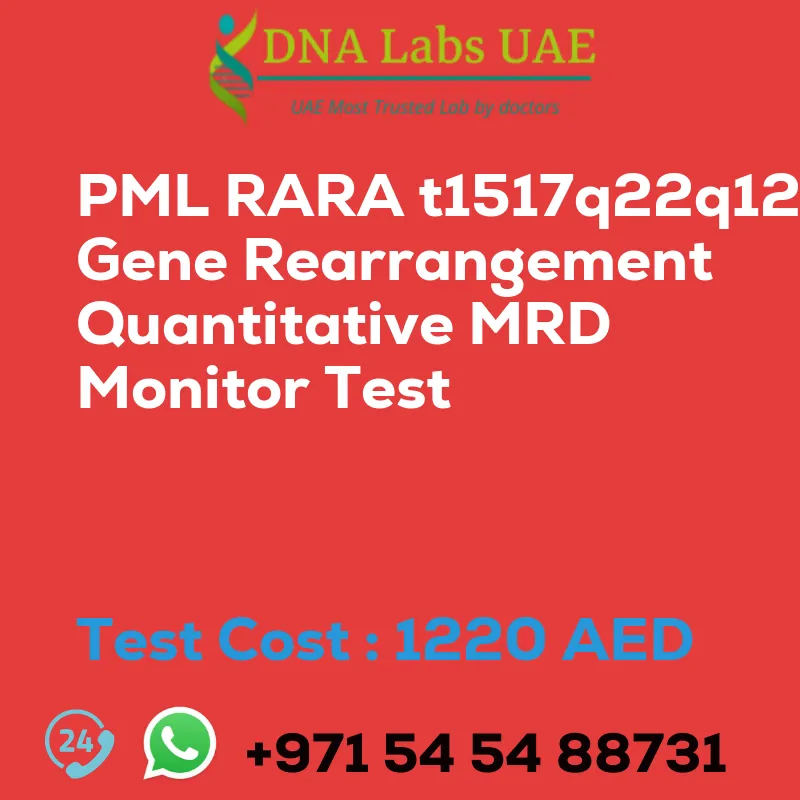PML RARA t1517q22q12 GENE REARRANGEMENT QUANTITATIVE MRD MONITOR Test
Welcome to DNA Labs UAE, where we offer the PML RARA t1517q22q12 GENE REARRANGEMENT QUANTITATIVE MRD MONITOR Test. This test is used to monitor minimal residual disease (MRD) in patients with acute promyelocytic leukemia (APL).
Test Details
The PML-RARA t(15;17)(q22;q12) gene rearrangement quantitative MRD monitor test is a diagnostic test used to monitor minimal residual disease (MRD) in patients with acute promyelocytic leukemia (APL). APL is a subtype of acute myeloid leukemia (AML) characterized by the presence of a specific chromosomal translocation between the PML gene on chromosome 15 and the RARA gene on chromosome 17.
This translocation leads to the formation of the PML-RARA fusion gene, which plays a critical role in the development of APL. The quantitative MRD monitor test is performed using molecular techniques, such as polymerase chain reaction (PCR), to detect and quantify the presence of the PML-RARA fusion gene in the patient’s bone marrow or blood samples.
MRD refers to the small number of cancer cells that may remain in a patient’s body after treatment and can potentially lead to disease relapse. Monitoring MRD levels during and after treatment is crucial in APL management, as it helps assess treatment response, predict relapse risk, and guide treatment decisions.
The quantitative MRD monitor test provides a quantitative measurement of the PML-RARA fusion gene, allowing clinicians to monitor MRD levels over time and make informed decisions regarding treatment adjustments or additional therapies.
Test Components
- Price: 1220.0 AED
- Sample Condition: 5 mL (3 mL min.) whole blood / Bone marrow in 1 Lavender Top (EDTA) tube. Ship refrigerated. DO NOT FREEZE.
- Duly filled MRD Requisition form (Form 22) with historical data is mandatory.
Report Delivery
Sample Mon / Wed / Fri by 9 am; Report Tue / Thu / Sat
Method
Real Time PCR
Test Type
Cancer
Doctor
Hematologist
Test Department
MOLECULAR DIAGNOSTICS
Pre Test Information
Duly filled MRD Requisition form (Form 22) with historical data is mandatory.
Overall, the PML-RARA t(15;17)(q22;q12) gene rearrangement quantitative MRD monitor test is an important tool in the management of APL, helping to monitor disease progression and guide treatment decisions to improve patient outcomes.
| Test Name | PML RARA t1517q22q12 GENE REARRANGEMENT QUANTITATIVE MRD MONITOR Test |
|---|---|
| Components | |
| Price | 1220.0 AED |
| Sample Condition | 5 mL (3 mL min.) whole blood \/ Bone marrow in 1 Lavender Top (EDTA) tube. Ship refrigerated. DO NOT FREEZE. Duly filled MRD Requisition form (Form 22) with historical data is mandatory. |
| Report Delivery | Sample Mon / Wed / Fri by 9 am; Report Tue / Thu / Sat |
| Method | Real Time PCR |
| Test type | Cancer |
| Doctor | Hematologist |
| Test Department: | MOLECULAR DIAGNOSTICS |
| Pre Test Information | Duly filled MRD Requisition form (Form 22) with historical data is mandatory. |
| Test Details |
The PML-RARA t(15;17)(q22;q12) gene rearrangement quantitative MRD monitor test is a diagnostic test used to monitor minimal residual disease (MRD) in patients with acute promyelocytic leukemia (APL). APL is a subtype of acute myeloid leukemia (AML) characterized by the presence of a specific chromosomal translocation between the PML gene on chromosome 15 and the RARA gene on chromosome 17. This translocation leads to the formation of the PML-RARA fusion gene, which plays a critical role in the development of APL. The quantitative MRD monitor test is performed using molecular techniques, such as polymerase chain reaction (PCR), to detect and quantify the presence of the PML-RARA fusion gene in the patient’s bone marrow or blood samples. MRD refers to the small number of cancer cells that may remain in a patient’s body after treatment and can potentially lead to disease relapse. Monitoring MRD levels during and after treatment is crucial in APL management, as it helps assess treatment response, predict relapse risk, and guide treatment decisions. The quantitative MRD monitor test provides a quantitative measurement of the PML-RARA fusion gene, allowing clinicians to monitor MRD levels over time and make informed decisions regarding treatment adjustments or additional therapies. Overall, the PML-RARA t(15;17)(q22;q12) gene rearrangement quantitative MRD monitor test is an important tool in the management of APL, helping to monitor disease progression and guide treatment decisions to improve patient outcomes. |








